Fri, Sep 09, 2011
Aviation Buff Believes French Team Crossed Atlantic, But
Crashed
On May 8, 1927, as Charles Lindbergh waited for a clearing in
the fog on Long Island to launch for Paris in the Spirit of St.
Louis, his rival, French World War I Ace Charles Nungesser,
departed with navigator François Coli in the opposite
direction. Both were seeking the $25,000 prize offered by hotelier
Raymond Orteig for the first crossing of the Atlantic between New
York and Paris, considered a key milestone in the development of
commercial airline service.

By the time Lindbergh departed 12 days later, there had still
been no sign of the French team in New York. A seldom-mentioned
sideline to Lindbergh's hero's welcome in Paris is the simultaneous
mourning which was underway for (pictured, L-R) Nungesser and Coli
who, by then, were presumed lost at sea after last being sighted
passing Ireland. Lindbergh is said to have inquired about any news
of his rival after his successful landing.
But their biplane, the Oiseau Blanc (or "White Bird"), was never
found. It was thought the plane might have made it to Maine and
crashed in a wilderness area. Others theorized it might have
crashed in Newfoundland.
The Wall Street Journal reports a French aviation enthusiast
named Bernard Decré has concluded that the White Bird flew
over the south coast of Newfoundland before ditching off the shore
of the Canadian mainland. Last year, he discovered a 1927 US Coast
Guard telegram in the US National Archives which reported sighting
"a pair of joined white wings" three months after the flight. His
research of Canadian Maritime weather on May 9, 1927, and
interviews with elderly Newfoundlanders who recall witness accounts
of the plane passing overhead, have the 71-year-old pilot, and many
others in France, excited.
There are now plans to employ divers and sonar to try to locate
any part of the Oiseau Blanc. Decré notes poignantly, "We
want to establish the true history of the tragic end of our pilots.
Then we want to answer Lindbergh's question, by saying we have now
had news of Nungesser."
More News
DETRESFA (Distress Phrase) The code word used to designate an emergency phase wherein there is reasonable certainty that an aircraft and its occupants are threatened by grave and i>[...]
"General aviation is at the forefront of developing and introducing innovative technologies that will transform the entire aviation industry..." Source: Kyle Martin, Vice President>[...]
Direct Straight line flight between two navigational aids, fixes, points, or any combination thereof. When used by pilots in describing off-airway routes, points defining direct ro>[...]
Aero Linx: Women in Corporate Aviation Women in Corporate Aviation support individuals seeking career advancement and professional development in the business aviation industry. Me>[...]
“We would like to thank the many volunteers that help throughout the year to pull off the event, as well as the several reviewers, judges, and SURVICE staff that provide team>[...]
 ANN's Daily Aero-Term (04.26.24): DETRESFA (Distress Phrase)
ANN's Daily Aero-Term (04.26.24): DETRESFA (Distress Phrase) Aero-News: Quote of the Day (04.26.24)
Aero-News: Quote of the Day (04.26.24) ANN's Daily Aero-Term (04.27.24): Direct
ANN's Daily Aero-Term (04.27.24): Direct ANN's Daily Aero-Linx (04.27.24)
ANN's Daily Aero-Linx (04.27.24) Aero-News: Quote of the Day (04.27.24)
Aero-News: Quote of the Day (04.27.24)



